What is Geothermal Energy?
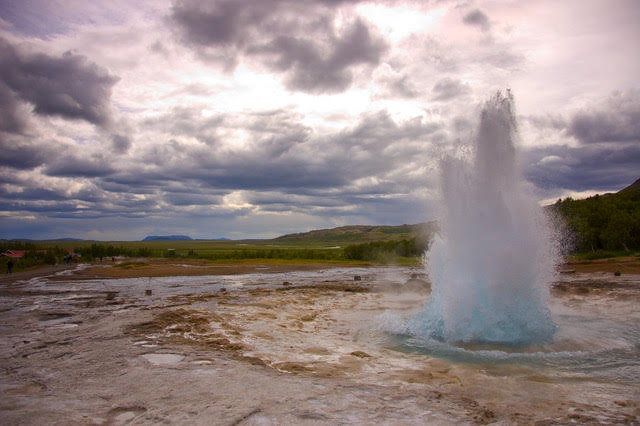
As a geothermal news website, we report on geothermal development with a focus on power generation and large-scale direct use of geothermal resources.
We see ourselves as an information tool for the industry and those wanting to learn more about geothermal energy and what it has to offer.
With this article, we want to give a short overview on geothermal energy, covering where it comes from, what it can provide and more.
It is the initial part of further articles to follow that will go in further depth on geothermal resources, project development, the various uses of geothermal energy, technical elements, policy and financing, and more.
Where Does Geothermal Energy Come From?
The term “geothermal“ actually comes from the words “geo” and “thermos”.
The Greek word “geo” stands for “earth”, usually in the sense of either ground or land, but in a prefix it also relates to the planet Earth.
Whereas, the word “thermos“ has its origin in Latin and Greek and refers to “hot” or “warm”.
Geothermal energy is thermal energy which is generated and stored within the Earth.
As described in Scientific American, the sources for that heat in the deep earth are the following:
- Heat from when the planet formed and accreted, which has not yet been lost
- Frictional heating, caused by the denser core material sinking to the centre of the planet
- Heat from the decay of radioactive elements.
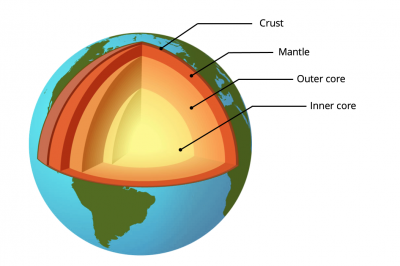
Source: Earth Layers Model. Wikimedia. CC. Mats Hallden.
The heat from the core of the earth takes a long time to move “out” of the earth.
The transfer occurs either through convective transport of heat within the liquid outer core and solid mantle of the earth, or through slower conductive transport of heat through non-convecting boundary layers, such as the earth‘s plates at the surface.
From the earth‘s surface, the temperature increases the deeper you go due to the “geothermal gradient”.
Essentially, the geothermal gradient highlights the increase in temperature per 100 m of depth – around 2-3 degrees Celsius.
To look at temperatures a few metres below ground level, corresponding to the mean annual temperature of the external air (e.g. 15 degrees Celsius), you can reasonably assume that the temperature will reach 65 to 75 degrees Celsius at a depth of 2,000 metres and 90-105 degrees Celsius at 3,000 metres depth.
This temperature trend continues a few thousand metres deeper.
However, there are great differences depending on where you are in the world.
For instance, areas with geologically young sediments would mean the geothermal gradient could be lower than 1 degree Celsius per 100m. Yet, in other areas the gradient can be ten times the average value.
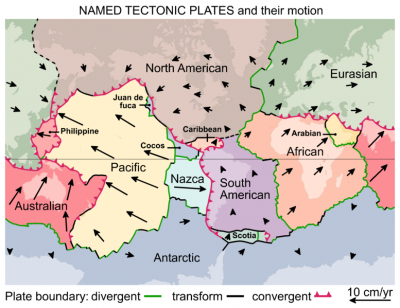
Source: Tectonic Plates Boundary Types. Wikimedia. CC. Hughrance.
The earth consists of a crust with 8 major tectonic plates we know today:
- Indian-Australian Plate
- Pacific Plate
- Antarctic Plate
- Nazca Plate
- North American Plate
- South American Plate
- African Plate
- Eurasian Plate
Where these tectonic plates meet, the heat of the earth can be found closer to the surface and is often manifested in volcanic activity.
Some of the tectonic plates move away from each other which can often create a rift.
For example, where the North American and the Eurasian Plate meet there is the most obvious rift clearly visible in the Thingvellir area in Iceland.
Alternatively, you can also see the San Andreas gap at the Western coast of the U.S. which goes south along all of the Americas.
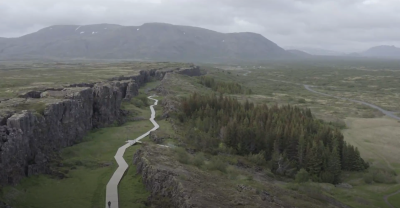
Source: Traveo. Thingvellir National Park, Iceland.
In the scenario, where plates move on top (or under) each other, you can often find mountain ridges such as the Himalayas.
A good example is New Zealand which is located on the ridge between the Pacific Plate and the Indian-Australian Plate.
These more “traditional” geothermal areas often have surface features that make “geothermal heat” visible, such as geysers and hot springs.
In these “obvious” geothermal areas, the depth to access geothermal energy for power generation or direct heat use is much less than in areas further away from those tectonic boundaries.
It is therefore likely not surprising that the historically predominant areas with geothermal energy use can be found in Italy, the United States, Iceland, New Zealand, Indonesia, and others.
In other areas of the world further away from the tectonic boundaries (e.g. in the southern part of Germany), there still is heat, but it requires much deeper drilling for access – this results in much higher costs.
While temperatures required for power generation might be accessible at depths as low as around 1,000 metres in Iceland, in Germany the target depth for usable temperatures can be up to 5,000 metres in the Molasse Basin south of Munich.
Direct Use of Geothermal Energy Resources
Geothermal energy, as we described before, is thermal energy. Utilising geothermal energy directly for its heat attribute is what we call “direct use”.
Heat plays an important role in the world and is often underestimated.
In the European Union alone, the demand for thermal energy (heating and cooling) is around 50% of total energy demand – this includes the energy demand for transportation.
So, utilising the heat provided by geothermal energy can be an important part of the energy supply.
Examples of direct use of geothermal heat are the following as well as a wider array of industrial applications requiring heat:
- Space and district heating
- Space cooling
- Greenhouse heating
- Aquaculture (fish farming)
The most obvious example is hot water used for bathing and swimming.
The many natural hot springs in the world and the commercial thermal spas from Roman times (e.g. in Bath/England or the famous Blue Lagoon in Iceland) are a good example.
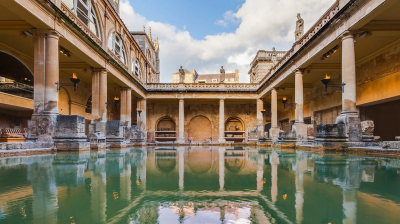
Source: Bath Roman Baths. Wikimedia. CC. Diego Delso.
Historically, baths heated by hot springs were used by the Romans and the Greeks.
Early examples of space heating with geothermal energy go as far back as the city of Pompeii during the first century A.D.
The first district heating system was installed at Chaudes-Aigues, France in the 14th century.
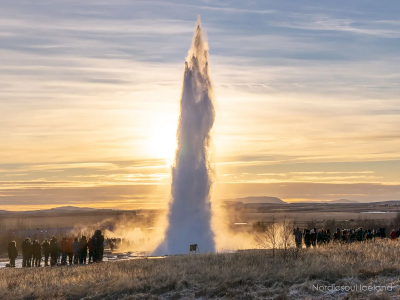
Source: Traveo. Geysir Geothermal Area, Iceland.
In the United States, the city of Boise, Idaho saw the first residences receiving heat through geothermal energy in 1892 from nearby hot springs.
Today, the geothermal district heating system in Reykjavik, Iceland is known as the largest single system.
Contrastingly, the city of Paris, France has a large number of individual geothermal district heating systems.
China, in efforts to curb pollution from coal fired heating, is also making huge steps towards using geothermal energy for district heating.
The use of heat from greenhouse operations is also a well-known example of direct use of geothermal energy. And it has allowed regions, like Iceland, to produce fresh produce year-round despite the harsher climate.
But even in countries like Kenya, Hungary or the Netherlands geothermal energy is now an elementary part in sustainable greenhouse operations.

Source: Greenhouse, Olkaria – Roses in Oserian’s greenhouses in Kenya. Wikimedia. CC. Oserian.
But available heat from geothermal also allows for other applications in the agriculture/ food sector.
Today, geothermal energy is used to dehydrate fruits, with examples in Greece and Mexico.
Actually, parts of commercially available “sun-dried” tomatoes from Greece, are “geothermal” dried.
In Mexico, a company is dehydrating fruits, such as pineapple and mangos, allowing overproduction not to go to waste. The company is also expanding markets beyond fresh produce for local markets into a commercial product that can be sold beyond.
Other examples are milk pasteurisation and dehydration, e.g. for the production of milk powder in New Zealand.

Source: Geothermally Dried Fruit in Mexico. GeoFood, Mexico.
The use of geothermal energy in aquaculture is also widespread with a great deal more opportunities still untapped.
From alligator farms to land-based fish farming, and growing fish in the early stage of sea-based fish farming are good examples.
Dehydrating seedlings and peet for greenhouse operations are also a good example of the wide range of applications.
Evidence points to the use of geothermal heat for cooking by Native Americans as early as 10,000 years ago.
Today, geothermal energy is still used for cooking in some traditional settings, (e.g. by the Maori people in New Zealand, Taiwan, Japan), including some bread-makers in Iceland – the Westman Islands is a good example of this.
For bathing and swimming, the healing factors of thermal waters have made natural hot springs historically an elementary part of people‘s lives where they could be found.
Today‘s more commercial operations include places such as the famous Blue Lagoon in Iceland (an artificial thermal bath utilising hot water from nearby geothermal power generation operations).
There have also been natural hot springs turned into commercial operations, such as the Banff Hot Springs in the Rocky Mountains in Alberta, Canada.
There are also numerous other examples ranging across Australia, China, India, Turkey, Hungary, to the U.S. and beyond.
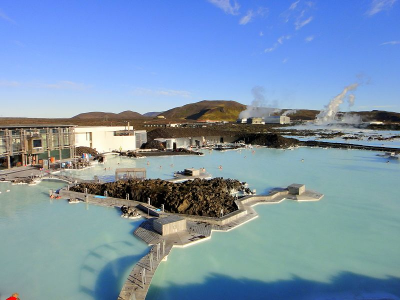
Source: Blue Lagoon, Iceland. Wikimedia. CC. Ainars Bruvelis.
Geothermal heat can also be used for cooling.
While sounding counterintuitive, the process of the absorption cycle has a refrigeration effect that turns heat into cold.
This effect is reached with the use of two fluids and a quantity of heat input rather than electrical energy (achieved with basic geothermal technology). This could be used for air-conditioning and district cooling systems.
There have been strong research efforts, and wells for planned geothermal district cooling to be drilled among others in Abu Dhabi and the UAE – there are also smaller scale projects in Australia.
Last but not least, geothermal heat pumps (or geo-exchange systems) are also one of the main uses of geothermal energy.
Geothermal heat pumps involve utilising lower temperatures in shallower depths for both heating and cooling.
Where is Geothermal Energy Used?
Geothermal energy is used all over the world.
Predominantly, geothermal energy has been used in areas with obvious surface manifestations of geothermal activity alongside the tectonic boundaries of this world.
Which Countries Use Geothermal Energy?
Today, there are 29 countries utilising geothermal energy for power generation.
The top countries based on geothermal power generation at present are the following:
- United States
- Indonesia
- Philippines
- Turkey
- New Zealand
- Mexico
- Italy
- Kenya
- Iceland
- Japan
The countries listed above represent around 90% of the power generation capacity.
However, the direct use of geothermal energy is much broader across the world.
There are today around 90 countries that report utilising geothermal energy for heat applications.
What is Geothermal Energy Used For?
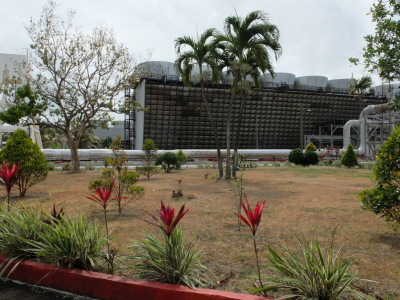
Image: Makban Plant, Philippines
Today, geothermal energy is used for power generation, or its heat attribute directly for applications such as: space heating, heating water for bathing, food production, food processing and greenhouse operations.
There are also additional elements connected to utilising geothermal energy.
Traditional, geothermal energy is derived by drilling for geothermal brine (hot water), which has a high mineral content. Some of those minerals are quite valuable, such as Lithium.
This has received increased attention in recent years with a growing demand for battery-grade lithium.
Given these attributes of geothermal energy, there are multiple opportunities for revenue generation from geothermal operations.
In cascaded use examples from Iceland, in so called Geothermal Resource Parks, hot water can be used to generate electricity and the remaining heat is still sufficient to be utilised for space heating for the following:
- Homes
- Nearby Greenhouses
- Fish farming
- Fish dehydration
- Bathing in thermal spas
The minerals can also be sold commercially or alternatively can be processed into products, such as skincare products.
What Are the Pros and Cons of Geothermal Energy?
There are a lot of advantages of using geothermal energy, but also a number of challenges.
Below you will find an overview of each of the main pros and cons of geothermal energy.
Geothermal Energy Pros
- The geothermal potential worldwide remains mainly untapped with still huge opportunities remaining for power generation, yet mostly for heat use.
- With responsible exploration and utilisation, geothermal energy is an environmentally friendly and sustainable energy source.
- The use of geothermal energy can cut back carbon emissions.
- It has the least land-use-intensiveness for energy generated of all renewable energy sources.
- It can provide energy around the clock, what we call a baseload capacity.
- It does not require any external fuel, such as fossil fuels for operation, therefore making it an important element in energy security being a domestic resource and curbing a dependency on availability and price fluctuations.
Geothermal Energy Cons
Given that geothermal energy is a natural resource it is very location specific, both in availability and economic viability in deriving it as energy.
For the higher temperatures required for power generation and the required depths to reach these resources, there are certain limitations based on the cost of extraction and utilisation.
Yet, with technological development, utilising lower temperature resources expand opportunities, particularly for direct use applications.
Environmental side effects can be a concern.
Drilling for geothermal resources can release gas stored under the Earth‘s surface.
Depending on the location, they can be higher or lower, but generally, the rate of these emissions is still far lower than those associated with fossil fuels.
Seismic activities in the form of earthquakes have “shaken” the reputation of geothermal in the proximity of several geothermal projects.
Drilling into stressed geological settings can release pressure and cause earthquakes.
If these are connected to drilling or the natural occurrence of earthquakes in specific regions is often under discussion.
With efforts to increase permeability of rocks for better fluid extraction, seismicity related to geothermal activities can occur.
At the same time with increased scrutiny, guidance and regulation, these risks can be managed.
There is a debate as to whether geothermal resources are sustainable.
In the early days of geothermal energy utilisation for power production, fluids were extracted without regard to the sustainability of the resource.
This utilisation resulted in a decrease in the productivity of various geothermal fields (e.g. at the Geysers in California, U.S).
Today, there are various measures in place and many jurisdictions require reinjection of fluids.
If managed correctly and there is a certain balance in extraction and reinjection, sustainability of fluids can be achieved.
With regards to extraction of heat itself and possible “cooling” off of the geological settings of geothermal reservoirs, there is no real evidence that this is indeed a challenge in the traditional time frames of electricity generation operations.
Today, there are various geothermal power plants in operations that have been operating for 50 years and more (e.g. in Italy and New Zealand).
Geothermal Energy Development
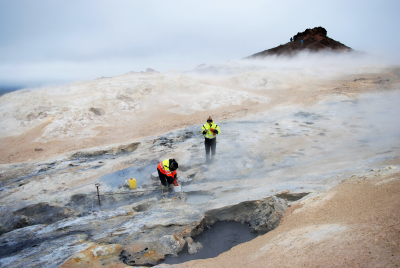
Source: Geothermal Field Research, Iceland. ISOR.
The most crucial aspect of geothermal energy development is exploration.
Obviously, the success of exploring for geothermal resources will determine if you can utilise them for energy applications.
The key elements of geothermal energy development are very much the same for power generation projects and projects to utilise or generate heat.
The early elements of development are focused on identifying and selecting potential areas for development, securing required permits, feasibility studies and securing funding.
The early exploration work then includes geological, geophysical, and geochemical evaluation and can include seismic measurements, followed by pre-feasibility studies.
The most crucial and costly element is the actual drilling to explore and tap resources.
When initial wells have been drilled and the resource and its potential output have been identified, the actual field development with drilling of additional wells also for reinjection.
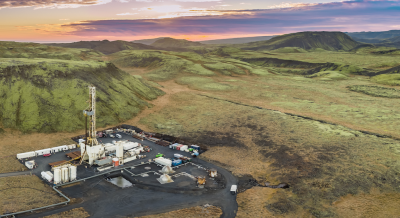
Source: Drilling at Hellisheidi, Iceland. Iceland Drilling.
The actual construction work, including the required pipe work for steam gathering, or hot water pipelines, will see the extraction of the power or heat plant for energy generation.
If the energy is then transferred in the form of electricity through transmission lines, or through pipes (e.g. in a district heating system) will determine the relevant infrastructure to be set up and allow for the start-up of the plant and its operation.
The cost of exploration and proving the resource is high and is often estimated at around 40-45%.
With the high risk associated with finding and proving the resource, it is often rather challenging for developers to secure the relevant funding.
When the resource has been proven to provide a sufficient supply of heat for the planned project, the actual financing of the production drilling and the power plant is much easier.
On average, geothermal project development can take around 6 years.
To the point that the project can move towards production drilling and construction of a plant, often 3-4 years have been spent on development.
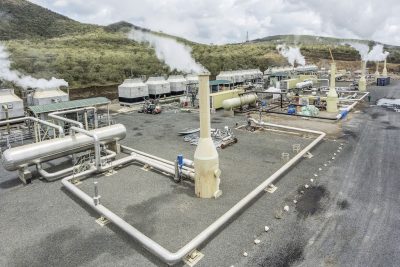
Source: Construction work at geothermal wellhead plants, Olkaria, Kenya. GEG Power.
Geothermal Energy Data
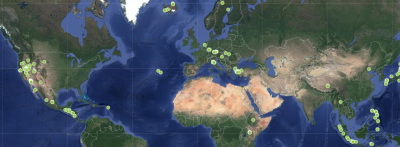
Image: ThinkGeoEnergy’s Geothermal Power Plant Map.
For the representation of the geothermal sector, it is crucial to have trusted data on both power and heat generation. Yet, data is relatively scattered and the level of quality also differs greatly by country.
The International Geothermal Association (IGA) has been publishing global updates on a 5-year basis with separate reports on geothermal power generation and geothermal direct use (including heat pumps).
These updates have been published in conjunction with the World Geothermal Congress by the IGA.
Other organisations have filled the gap in between reporting data on the status of geothermal power generation, such as REN21 and the International Renewable Energy Agency (IRENA).
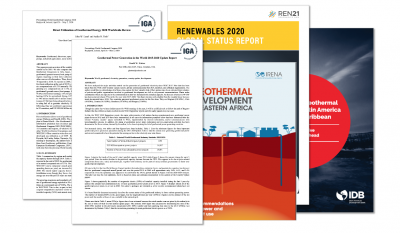
Source: Samples of IGA Geothermal Reports. IGA.
There are several challenges in collecting data on geothermal operation, project development, particularly for heat projects and operations.
The approach to the reporting of geothermal data differs greatly by country and often does not allow for a unified reporting of global data.
Gathering data on geothermal power plant development is difficult and with our ongoing work on updating our own databases, we constantly tweak, update and correct data as we go along.
As a disclaimer for the data presented, you will find discrepancies in the data reported by different sources and there are many reasons for this.
Some organisations report gross capacity, whereas others report on operating, installed capacity, or even simply take averages of summer and winter capacity.
They all have one challenge in common – countries and organisations are often not presenting the same numbers. The result is that numbers for one country cannot be compared with another.
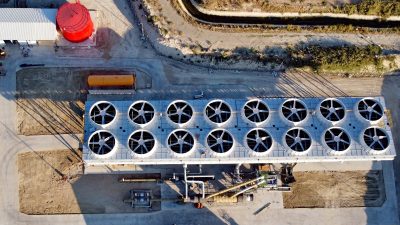
Source: Emirler Geothermal Power Plant, Turkey. Ormat.
ThinkGeoEnergy decided to apply installed nameplate power generation capacity, but only reflect that capacity that is operating – no matter if the plant produces at full capacity or not.
We try our best to exclude plants and MW that are not operating, but it is not easy. For some countries, one simply has three or four different datasets and needs to make a decision that might prove to be wrong in the end.
So, while we now have a rather good grip on data related to geothermal power, the picture is a little bit different for direct use. There clearly is a large void.
It is absolutely crucial for the geothermal sector to be able to highlight the direct use of geothermal, both in potential and current utilisation, the task is tremendously difficult due to the limited data available.
ThinkGeoEnergy maintains an extensive database on geothermal power operations and projects worldwide.
As part of our work we are sharing some of our data as part of our news reporting, but also as part of our research offering.
For direct use, we are exploring ways to better include this in both our reporting and the gathering of data to meet the increasing demand for reliable data.